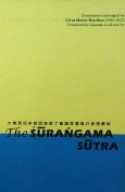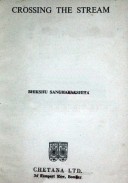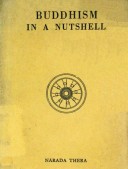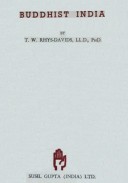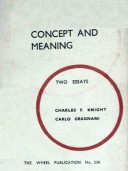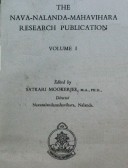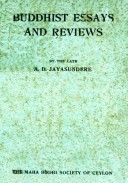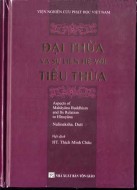Tìm Sách
Sách tiếng Anh-English >> The Surangama Sutra
Thông tin tra cứu
- Tên sách : The Surangama Sutra
- Tác giả : Lu K’uan Yu - Charles Luk
- Dịch giả : Lu K’uan Yu - Charles Luk
- Ngôn ngữ : Anh
- Số trang : 331
- Nhà xuất bản : Buddha Dharma Education Association Inc.
- Năm xuất bản : 2005
- Phân loại : Sách tiếng Anh-English
- MCB : 12010000007133
- OPAC :
- Tóm tắt :
PREFACE
We take refuge in the Buddha,
We take refuge in the Dharma,
We take refuge in the Sahgha,
We take refuge in the Triple Gem within ourselves.
This important sermon contains the essence of the Buddha’s teaching and, as foretold by Him, will be the first sũtra to disappear in the Dharma ending age. It reveals the law of causality relating to both delusion and enlightenment and teaches the methods of practice and realization to destroy forever the roots of birth and death. It aims at breaking up ălaya, the store consciousness, whose three characteristics are: self-evidencing, perception and form, by means of the three meditative studies of noumenon which is immaterial, of phenomenon which is unreal and of the ‘Mean’ which is inclusive of both, and leads to the all-embracing Sũrarigama samãdhi which is the gateway to Perfect Enlightenment and reveals the nature of the Tathãgata store of One Reality.
In the practice of the Sũrarigama samãdhi to wipe out the store consciousness, we should know that the latter has been under delusion for a very long time and that it is very difficult to transmute it into the Great Mirror Wisdom. Hence the Buddha uses two of its characteristics, perception and form, to explain the falseness of both so that we can relinquish our attachment to them and break its first characteristic, self-evidencing. The illusion of form which includes the body and mind made of the five aggregates and the visible world is tackled first by returning each of its aspects to where it arises to prove its unreality. Then the illusion of perception is wiped out by revealing its essence, or ălaya, which like a second moon is also an illusory creation. Hence the Buddha says: ‘When seeing (perceives) seeing, seeing is not seeing (for) seeing strays from ‘seeing; seeing cannot reach it, which Han Shan ably interprets thus: ‘When the absolute seeing perceives the essence of seeing, the former is not the latter which still differs from it; how then can false seeing reach that absolute seeing?’ Absolute seeing is likened to the real moon in the sky; the essence of seeing to a second moon seen by bad eyes; and false seeing to the moon’s reflection in water. In other words, the true moon stands for basic Enlightenment; the second moon for ãlaya, or the essence of seeing which is close to the true moon; and the moon in water for perception, an illusion which is very far from the real moon. As to ãlaya which is the unenlightened aspect of the self-nature, we cannot lightly dismiss it as non-existent; and this is why the Buddha avoids mentioning it for, as He says in His gãthã:
‘Old habits flow like torrents in
Ãlaya’s subtle consciousness.
Since the real yet unreal can create confusion
I have refrained from revealing it to you.’
In answer to Ananda’s request for insfruction on the three meditative studies (samaiha, samãpatti and dhyãna), the Buddha reveals the light of Sũrangama samãdhi from the host position of the all-embracing One Mind in its state of passionless imperturbability. Readers should not regard this revelation as some kind of miracle which cannot be proved by science and which should be dismissed as nonsense. We have mentioned in our previous book, The Secrets of Chinese Meditation, that all serious students of the Dharma experience this state of brightness as soon as they succeed in stilling their minds in the practice of dhyãna.
This absolute Mind as revealed by the Buddha, has three great characteristics: greatness of its essence or substance, called Dharmakãya; greatness of its attributes or manifestations, perfect in wisdom and mercy, called Sambhogakãya; and the greatness of its functions, perfectly converting all living beings to the right Path, called Nirmãnakãya.
Instead of cognizing the True Mind, we cling-to the illusory body and mind made of the five aggregates as an ego, with sense data in the surrounding world as its objective field of activity. This coarse attachment to ego and things (dharmã) arises from discrimination and pertains to both the sixth and seventh consciousnesses. The subtle attachment to ego and Dharma is inborn for it arises from the seventh consciousness clinging to alaya’s perception as an inner ego and its realization of sainthood as Dharma. Only after wiping out both discriminative and inborn attachments can we reach the source of the One Mind and attain Enlightenment. Hence the three meditative studies which aim at destroying both coarse and subtle clingings.
It is much easier to relinquish the discriminative clinging than the inborn attachment and few practisers succeed in overcoming the latter; hence Han Shan says: ‘This pass is the most difficult one to get through and only one or two percent of practisers can succeed in negotiating it’ (See The Secrets of Chinese Meditation, p. 58, Rider and Co.) Here is the great difference between the Buddha Dharma and the teachings of other religions in the Orient.
The inborn attachment to an ego can be cut off only after one has reached the seventh stage of Bodhisattva development whereas the inborn clinging to Dharma still remains in and above the eighth stage, for the seventh consciousness has its unclean and clean characteristics. The unclean one is wiped out in the seventh stage when the name of store consciousness is dropped and replaced by that of pure consciousness which can now be transmuted into the Absolute. However the seventh consciousness still remains and clings to the Absolute as the object aimed at; this is the subtle attachment to Dharma. Hence the Buddha says: The idea that Bodhi Mind is created after the samsaric mind has been annihilated pertains to samsãra’ (see p. 99), for this clinging to the Absolute that can be attained also implies the duality of subject and object, that is attachment to Dharma. Only after this last attachment has been cut off can Enlightenment be realized. These two coarse and subtle attachments do not go beyond the Eighth Consciousness and its created five aggregates; the breaking up of which is the aim of the teaching in this sũtra.
This sermon deals with basic Ignorance caused by the first dim thought of self-awareness as subject and its counterpart, dull emptiness, as object The dimness so created by mind’s separateness is called Primordial Darkness by non-Buddhist philosophers in the East and is the origin of creation according to the Buddha’s teaching which then explains the three subtle causes of unenlightenment: basic ignorance, subject and object, and its six coarse conditions: knowledge, responsiveness, attachment, assigning names to objects, karmic activity and suffering. These six conditions result in the manifestation of different forms, such as the world and living beings in the store consciousness. Here begins the law of continuity: that of the physical world resting on the four wheels of wind, water, metal and space which spring horn the illusion thus created; that of living beings of the four types of birth; and that of karmic retribution caused by carnality, killing and stealing, the three cardinal conditions of birth and death.
The Buddha orders the twenty-five enlightened ones in the assembly to disclose the various means by which they have attained enlightenment so that others can learn something horn them. After their statements of their realization by means of the six sense data, six sense organs, six consciousnesses and seven elements of fire, earth, water, wind, space, consciousness and perception, the World Honoured One asks Mafijusri for his opinion on these twenty-five methods. Mafijusri praises Avalo- kitesvara Bodhisattva for the latter’s method by means of the organ of hearing which is the most suitable for human beings.
The Buddha then teaches the assembly the Surangama mantra and rituals for avoiding all obstructions on the Path to Enlightenment. We have not presented this section of the sutra partly because the Chinese transliteration of the mantra is corrupt so that an English transliteration would be misleading, and partly because of lack of space. Moreover, the average Western student of Buddhism seems to have little faith in mantras and rituals which should not be published lest they create unnecessary disbelief and confusion and so compromise the beauty of this profound sutra.
The Buddha goes on to explain why living beings are caught in the net of samsãra through the twelve types of birth and how to escape by practising the fifty-five gradual stages of Bodhisattva development to realize Complete Enlightenment. As asked by Ananda, He described the realms of hells, the ten realms each of hungry ghosts, animals, human beings and seers; the six deva realms of desire, the eighteen deva realms of form, the four deva realms beyond form and the four realms of titans.
Before the meeting ends, the Buddha warns the assembly against fifty mental states caused by the five aggregates which hinder the practice of Dharma. These states should be recognized by all students in their meditation and cases are known of those having visions of Buddhas and Bodhisattvas who by clinging to them, fell into heresy and thereby returned to samsãra.
This translation is based on the explanation and commentary written by Master Han Shan of the Ming dynasty after his own enlightenment. The original Chinese text is a forest of vertical columns and is not divided, as in our presentation, into chapters with headings and sub-headings which the master added for the benefit of students. After this, important sũtra reached China it was read and studied by all great masters before and after their major awakening, and was widely expounded and commented on in all well-known monasteries throughout the country. According to the late master Hsu Yun, it should be studied carefully until it is well understood by students of Mahãyăna and Ch’an before they begin their spiritual training.
In spite of our desire long ago to present this sũtra to sincere students in the West, we hesitated to do so because it is very profound and is beyond the comprehension of materialistic commentators and blasphemers who are inclined to seize every opportunity to criticize and vilify the holy Teaching thereby misleading the reading public and causing embarrassment and even loss of money to well-meaning publishers. A European book reviewer recently took the unnecessary trouble to question our competence to translate sũtras in Sanskrit without appreciating that we have only Chinese sũtras in our country so that all our translations are from Chinese texts.
We are, however, indebted to our two Canadian readers, Mr. and Mrs. Carroll Aikins, who have studied and practised Mahãyãna and Ch’an for some thirty-five years and who, when hearing of our hesitation during their visit to Hong Kong in 1963, immediately offered to purchase a thousand copies of our translation for free distribution. They told us that it was worth spending money to spread the Buddha Dharma, and we can find no words to express our thanks and gratitude for their encouragement and valuable support in this Dharma ending age.
All brackets are mine and are added to make the sũtra and commentary more clear and intelligible to sincere students of the Dharma in the West. Only part of Han Shan’s commentary has been translated and is presented in the form of footnotes.
Upãsaka Lu K’uan Yu (Charles Luk)
Hong Kong
Contents of the Sũrangama Sũtra
Comment……………………………….. iii
Translator……………………………….. v
Preface………………………………….. 15
I
The Noumenon in the Tathãgata Store… 24
Ãnanda’s Weakness – The Reason for this Sermon.. 25
Meditative Study of All as Void (Samatha)…………. 26
Wiping Out the Five Aggregates &
Eight Consciousnesses to Expose the Unreality of Ego….. 27
Revealing the Bright Samãdhi……………………………. 38
Origin of Inversion…………………………………………… 39
Actual Inversion………………………………………………. 41
The Inverted Mind……………………………………….. 41
Probe into the false mind………………………….. 41
Thinking is unreal……………………………………. 41
The sixth consciousness Is empty………………. 42
The seventh consciousness is unreal…………… 43
Refuting all inversion……………………………….. 45
The Inverted Perception………………………………… 45
A bright Light to reveal the One Reality……… 46
Returning perception to Mind……………………. 46
Inverted Men……………………………………………….. 48
The worlding’s inverted views……………………. 49
The Hinayanist’s inverted views………………… 50
The heretics’ inverted view of annihilation …. 52
The inverted behaviour…………………………….. 55
Delusion and Enlightenment are of the same source ….55
Wiping Out the Unreal ……………….. 59
The Non-existence of Discriminative Perception. 59
Ananda’s wrong view …………….. 59
Unreality of illusory causes……… 59
Falseness of both sense organs and consciousness… 60
All phenomena returnable to causes are unreal 61
Borrowing The Essence Of Perception To Pick Out Causal Externals.. 61
Setting up the essence of perception…… 62
Picking out causal externals …………….. 62
The nature of perception………………….. 63
The (Underlying) Nature of Perception is Not the Essence of Perception…63
The capacity of perception……………….. 64
Picking out causal objects…………………. 64
The essence of perception ………………… 65
The Essence of Perception Mistaken for Externals…….. 65
Refuting this misconception …………….. 65
True perception………………………………. 66
Wiping Out the Capacity of Perception to Reveal the True Mind … 66
The capacity of seeing……………………… 66
Breaking up the capacity of seeing…….. 67
Revealing the Real………………….. 67
Eradicating Attachment to the Ego to Reveal the One Reality………. 68
Rooting Out Ananda’s Misconception of Objects
Being and NOT BEING Perception …… 69
Misconception of objects BEING perception……….. 69
Misconception of objects NOT BEING perception . 70
Manjusri’s Helpful Interposition …………… 72
Wiping Out Alaya’s Self-Evidencing to Reveal One Reality… 74
Ananda’s Discrimination………………….. 74
Wiping Out Ananda’s Discrimination…….. 74
Rooting out the self as such………………. 74
Eliminating cause and condition………… 75
Revealing the essential Bodhi …………… 75
Brushing away wrong assumptions…… 76
Eliminating the Essence of Perception to Reveal Inceptive Enlightenment. 76
Wiping Out Ananda’s Discrimination ……. 76
Revealing the Inceptive Bodhi …………………… 77
Individual Karma………………………………… 80
Collective Karma…………………………………. 81
Revealing the Independent Basic Bodhi to Expose
the Unfettered Absoluteness (Bhutatathata)…….. 83
Wiping Out All Traces of the False to Enter the Abstruse
to Reveal the Bhũtatathatã …………………………… 84
Direct Pointing to the One Mind…………….
Fusing Myriads of Things with the Absolute to Reveal
the Identity of Phenomenon with Noumenon……. 87
Fusing the Five Aggregates……………….. 87
The First Aggregate Rũpa…………….. 87
The Second Aggregate Vedanã……… 88
The Third Aggregate Safljfia…………. 89
The Fourth Aggregate Samskãra…… 90
The Fifth At^regate Vifiana………….. 90
Fusing the Six Entrances……………… 91
Entrance through the Eyes……………. 91
Entrance through the Ears……………. 92
Entrance through the Nose…………… 93
Entrance through the Tongue……….. 93
Entrance through the Body…………… 94
Entrance through the Intellect……….. 95
Fusing the Twelve Ãyatana (Six Sense Organs & Six Sense Data)……. 96
Eyes & Form…………………………….. 96
Ears & Sound……………………………. 97
Nose & Smell …………………………….. 98
Tongue & Taste…………………………. 99
Body & Touch…………………………… 99
Intellect & Dharma……………………. 100
Fusing the Eighteen Fields or Realms of the Senses ………… 101
The Field of Sight-Perception……… 101
The Reid of Sound-Perception…….. 102
The Field of Smell-Perception……… 103
The Reid of Taste-Perception……… 105
The Reid of Touch-Perception…….. 106
The Field of the Sixth Consciousness……. 107
Fusing the Seven Elements into the Absolute to Reveal
the Free Intermingling of Phenomenon & Noumenon…… 108
Exposing Faulty Differentiation …………. 109
Pointing to the One Source…………………. 109
Instruction on the Seven Dements……….. 110
The element of earth……………………………….. 110
The element of fire…………………………………. 111
The element of water ……………………………… 112
The element of wind……………………………….. 114
The element of space ……………………………… 115
The element of perception……………………….. 117
The element of consciousness………………….. 119
Ananda’s Understanding Expressed in his Gãthã …… 122
II
The Phenomenon in the Tathãgata Store…………. 124
The Meditative Study of All as Unreal (Samãpatti) 124
The One Mind Being the Source of Both Delusion & Enlightenment 124
A Probe into the Disciple’s Understanding of
Noumenon & Phenomenon to Reveal the Rise of Illusions. 126
The Real Missed by Cognizance of the False ……… 126
The Three Finer Conditions of Unenlightenment
(Basic Ignorance: Subject & Object)………….. 127
The Six Coarser Conditions of Unenlightenment… 127
The Law of Continuity……………………….. 128
Continuity of the (physical) universe……. 128
Continuity of living beings …………………. 129
Continuity of karmic retribution………….. 131
The Uncreated & Unending………………………………………………….. 132
The Unhindered Intermingling of Noumenon & Phenomenon……. 133
Expounding the Common Source of Delusion & Enlightenment to
Sum Up the Intermingling of Phenomenon & Noumenon…………. 135
III
The Tathãgata Store Containing Both Noumenon & Phenomenon…. 137
Meditative Study of the Mean (Dhyãna) ……………. 137
Elimination of ‘is’ to reveal the True Mind… 137
Elimination of ‘is not’ to reveal the True Mind……. 138
Simultaneous elimination of ‘is’ & ‘is not’ to reveal the Absolute Mind. 138
The One Mind, Sudden Awakening & Realization. 139
IV
Self-Enlightenment………………………………………… 146
Objects Contemplated in Meditative Studies………. 146
The subjective mind in the meditation……….. 147
The objective phenomena in the meditation.. 147
The point of departure……………………………. 150
Looking into the roots of klesa to find
the sense organ suitable for meditation……… 150
Expedient Instruction on the One Mind …………….. 158
Main Instruction on the Three Meditative Studies of the One Mind 162
How to Untie the Six Knots…………………………….. 166
Meditation on the six sense data ……………… 171
Meditation on the five sense organs …………. 175
Meditation on the six consciousnesses………. 178
Meditation on the seven elements ……………. 183
Meditation on the organ of hearing…………… 191
Manjusri’s Gãthã Teaching the Appropriate Method for Human Beings 203
V
The Enlightenment of Others…………………………. 213
Discipline & its Three Decisive Steps: S3a, Dhyãna, & Prajna 214
Prohibition against carnality……………………. 214
Prohibition against killing……………………….. 215
Prohibition against stealing……………………… 217
Prohibition against lying…………………………. 220
VI
Bodhisattva Development into Buddhahood……. 222
The Tathãgata Store from which Arise Both Samsãra & Nirvana 223
The Origin of Living Beings & the World…………… 223
The Inverted Cause of the Existence of Living Beings……… 224
The Inverted Cause of the Existence of the World …. 225
The Twelve Types of Transformation………….. 225
The Twelve Groups of Living Beings ………….. 229
Transmutation of Samsãra into Nirvana……………. 229
The Three Gradual Steps to Wipe Out Samsãra….. 229
Progressive Advance in Bodhisattva Development 232
The Stage of Dry Wisdom…………………………… 232
The Ten Stages of Bodhisattva Faith ……………. 232
The Ten Practical Stages of Bodhisattva Wisdom……. 234
The Ten Lines of Bodhisattva Action …………… 236
The Ten Acts of Dedication (Parinãmanã)……… 237
The Four Additional Harnessing Stages (Prayoga) ….. 239
The Ten Highest Stages of Bodhisattva Attainment (Dasabhumi).. 240
The Universal Enlightenment……………………….. 241
The Absolute (or Wonderful) Enlightenment …. 242
The Titles of this Sũtra …………………………………… 242
VII
The Six Planes of Existence Caused by Unenlightenment…… 244
The Six States of Living Beings in Samsãra……….. 244
The realm of devas…………………………………. 247
The realm of seers (rsi) and spirits …………… 247
The realm of human beings …………………….. 248
The realm of animals………………………………. 248
The realm of hungry ghosts ……………………. 248
The realm of hells…………………………………… 248
The Ten Causes & Six Effects in the Realm of Hells…….. 249
The Ten Karmic Causes of the Realm of Hells …… 249
The habit of sexual desire……………………….. 249
The habit of craving ………………………………. 250
The habit of arrogance……………………………. 250
The habit of anger …………………………………. 250
The habit of deceitfulness………………………… 251
The habit of lying…………………………………… 251
The habit of resentment………………………….. 252
The habit of wrong views………………………… 252
The habit of unfairness ………………………….. 253
The habit of disputation………………………….. 253
The Six Retributive Effects in the Realm of Hells… 254
Retributive effects of wrong seeing…………… 254
Retributive effects of wrong hearing ………… 254
Retributive effects of wrong smelling………… 255
Retributive effects of wrong tasting………….. 256
Retributive effects of wrong touching……….. 256
Retributive effects of wrong thinking………… 257
Degrees of Perversity in Relation to Suffering in the Hells… 258
The Ten Categories in the Realm of Hungry Ghosts 258
The Ten Categories of Animals (Birds, etc.)……….. 260
The Ten Categories in the Realm of Human Beings 262
The Ten Categories in the Realm of Seers (Rsis)…. 263
The Realm of the Gods (Devaloka) …………………… 265
The Six Heavens of the Realm of Desire (Kãmadhãtu).. 265
The Four Regions of the Dhyãna Heavens
of the Realm of Form (Rũpadhãtu)……………………. 267
The first region of the three dhySna heavens………. 267
The second region of the three dhyăna heavens ….. 268
The third region of the three dhyãna heavens……… 268
The fourth region of the four dhyãna heavens…….. 269
The five heavens from which there is no return…… 270
The Four Heavens of the Formless Realm of Pure Spirit (Arũpadhãtu) 272
The state of the Great Arhat…………………… 272
The four heavens beyond form……………….. 272
The Anãgãmin stage………………………………. 273
The Four Classes in the Realm of Titans (Asura-gati)…… 274
VIII
Warning to Practisers: The Fifty False States Caused
by the Five Aggregates…………………………………… 277
States of Mara Caused by the Five Aggregates……. 277
The Ten States Affected by the First Aggregate of Form (Rũpa) 280
The Ten States Affected by the Second Aggregate
of Receptiveness (Vedanã)…………………………… 284
The Ten States Affected by the Third Aggregate of Conception (Safijfia)… 291
The Ten States Affected by the Fourth Aggregate of
Discrimination (Sarnskara)……………………… 304
The Ten States Affected by the Fifth Aggregate of Consciousness (Vijana)…. 316
The Falsehood of the Five Aggregates……………….. 325
Falseness of die first aggregate of form (rũpa)… 326
Falseness of the second aggregate of receptiveness (vedani). 327
Falseness of the third aggregate of conception (safiifia)……. 327
Falseness of the fourth aggregate of discrimination (samskãra). 327
Falseness of the fifth aggregate of consciousness (vijfiana)… 328
Glossary……………………………… 331
 Facebook
Facebook
 Google
Google
 Google+
Google+
